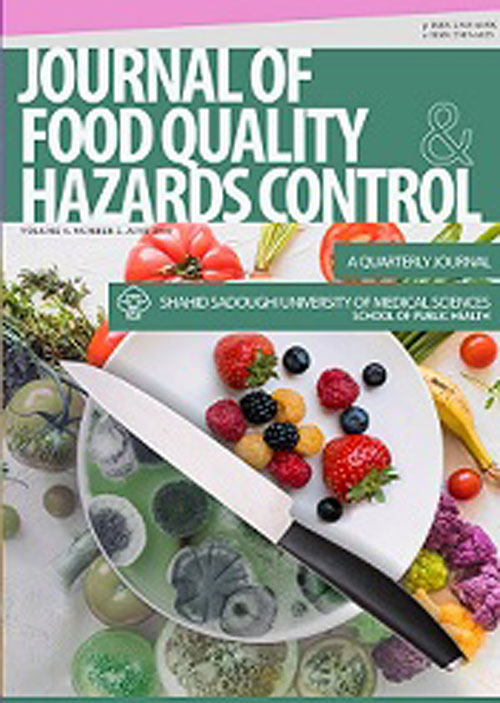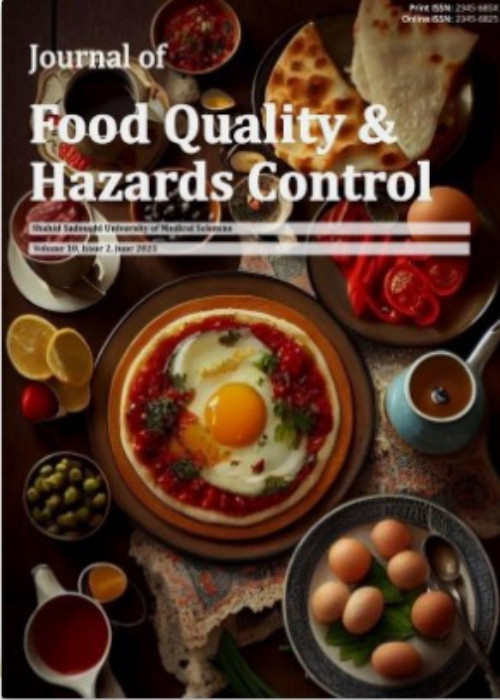فهرست مطالب

Journal of Food Quality and Hazards Control
Volume:6 Issue: 2, Jun 2019
- تاریخ انتشار: 1398/03/11
- تعداد عناوین: 8
-
-
Pages 45-52BackgroundReady-To-Eat (RTE) foods include any edible food that is commonly consumed raw. This study aimed at evaluation of microbial ecology of retail RTE escarole and red chicory sold in Palermo city, Italy.MethodsA total of 32 mono-varietal RTE samples, including escarole (n=16) and red chicory (n=16) samples were obtained from Palermo, Italy. Both RTE vegetables at expiry date were analyzed to quantify spoilage bacteria, pathogenic bacteria, and yeast. All different colonies were isolated and identified on the basis of phenotypic characteristics and genetic polymorphisms by random amplification of polymorphic DNA-Polymerase Chain Reaction (PCR) and further genotype by sequencing the 16S rRNA gene. The statistical analysis was conducted with SAS 9.2 software (Statistical Analysis System Institute Inc., Cary, NC, USA).ResultsThe level of Listeria monocytogenes and coagulase-positive staphylococci were below the detection. Total microbial counts were above 8 log10 colony forming unit/g in RTE red chicory, while they were about 1 log cycle lower in escarole. In general, escarole showed lower levels for all microbial groups than red chicory with the exception of the total yeast. A total of 13 strains were identified into ten species belonging to six genera as Bacillus, Erwinia, Pantoea, Pseudomonas, Microbacterium, and Rahnella. The most numerous identified genera were Pseudomonas and Pantoea.ConclusionThis work pointed out the relevance of implementing good hygiene practices during processing in order to prolong quality parameters and acceptability of mono-varietal salads.Keywords: Food Microbiology, Food Safety, Vegetables, Chicory, Italy
-
Pages 53-57BackgroundIn Benin Republic, the conservation of fermented fishes for a long time is difficult due to the contamination of fungi, which lead to its rapid degradation. This experiment was conducted to evaluate the effect of Cymbopogon citratus Essential Oil (EO) against Aspergillus species isolated from fermented fish samples.MethodsGas chromatography-mass spectrometry was used to determinate the chemical composition of the C. citratus EO. The agar dilution method was used to evaluate the antifungal activity of the C. citratus EO against Aspergillus species. Data were analyzed using SPSS, Chicago, IL, USA, version 10.0.ResultsThe major components of C. citratus EO were geranial (41.3%), neral (33.0%), myrcene (10.4%), and geraniol (6.6%). The dominant Aspergillus fungi isolated from the fermented fish samples were A. ochraceus, A. oryzae, A. fumigatus, and A. parasiticus. C. citratus EO exhibited considerable antifungal activity against the growth of fungi isolated from fermented fish samples. There was no significant difference between minimal inhibitory concentrations and minimal fungicidal concentrations of A. ochraceus and A. parasiticus (p>0.05).ConclusionThe findings of this research clearly indicate that the C. citratus EO may be a practical application in controlling the growth of Aspergillus species in fermented fish.Keywords: Cymbopogon, Oils, Volatile, Fish Products, Antifungal Agents
-
Pages 58-65BackgroundIn food industry, carotenoids are used as food colorants conferring yellow to red color. This research was designed to study on lipid and β-carotene production by Rhodosporidium diobovatum cultured with different Carbon to Nitrogen (C/N) ratios.MethodsR. diobovatum was cultured in a medium containing 40 g/l glucose (as the carbon source) and different C/N ratios (20, 50, and 80), which were established by adding different amounts of (NH4)2SO4 (3.78, 1.51, and 0.94 g/l) as the source of nitrogen. High performance liquid chromatography, gas chromatography, and microplate reader were used to determine the glucose concentration, lipid production, and β-carotene concentration, respectively. Data were analyzed using IBM SPSS statistics (v. 24).ResultsCultures with a C/N ratio of 50 produced the greatest amount of lipids during 120 h pi. However, lipid synthesis in the first 48 h pi was very low for all three C/N ratios. Analyses of the lipid composition revealed that oleic acid and linoleic acid were the dominant (60%) fatty acids. Cultures with a C/N ratio of 50 also produced the greatest amount of β-carotene.ConclusionR. diobovatum in the C/N of 50 culture medium resulted in greater concentrations of lipid and β-carotene. Defining the optimum C/N ratio will enable development of optimized bioprocess engineering parameters for scale-up production of lipid and β-carotene in food industries by this yeast species.Keywords: Yeasts, Lipids, Carotenoids, Food Industry
-
Pages 66-72BackgroundLactic Acid Bacteria (LAB) are an important group of microorganisms responsible for the fermentation dairy products. This study was done to identify the dominant lactic acid bacteria in naturally fermented milks from Messinese goat’s breed.MethodsEighteen individual raw milk samples collected from Messinese goat’s breed were acidified at pH 5.20 and left to spontaneously ferment at 37 °C for 4 days. All samples were analyzed for rod- and coccus-shaped LAB. Also, all presumptive LAB were isolated and differentiated according to their phenotypic properties and genetic polymorphisms and then identified by sequencing the 16S rRNA gene. Data were statistically analyzed using SAS 9.2 software.ResultsLevels of coccus- and rod-shaped LAB were in the range of 1.78-7.10 log and 1.00-7.09 log colony forming unit/ml, respectively. The microbiological counts on the two different growth media were significantly (p<0.05) different among the samples. Among 12 identified strains, the most numerous one was Enterococcus hirae (n=4), followed by E. faecium (n=3), while the other species (E. durans, E. faecalis, E. lactis, Lactococcus lactis, and Leuconostoc lactis) included one strain each.ConclusionThe major group identified in this study was mainly represented by members of Enterococcus genus. Although Enterococcus spp. are related to the typicality of some traditional fermented dairy products, this study highlights the need for risk assessment of pathogenic enterococci species for the consumers.Keywords: Milk, Goats, Lactobacillales, Cultured Dairy Products, Food Microbiology
-
Pages 73-78BackgroundModified Atmosphere Packaging (MAP) is one of the most convenient packaging methods that could be useful in reducing the wastes and extending the crops’ shelf-life. This research aimed to assess the impact of MAP containing high concentrations of carbon dioxide on physicochemical, microbial, and sensorial properties of Iranian Mazafati date.MethodsDate samples were packed separately in control and MAP treatment groups and stored at 5 and 25 °C. After 30, 60, and 90 storage days, acidity, Brix index, total count of bacteria, molds, and yeast, texture hardness, wettability, flavor, color changes of samples were evaluated. The data were analyzed by MSTAT-C software.ResultsAcidity, Brix, and microbial loads in the MAP treatment groups were significantly (p<0.05) lower than control group. Hardness values of the date samples were significantly (p<0.05) decreased during 30, 60, and 90 days of storage time using MAP with low temperature. The MAP group at 5 °C and control group at 25 °C had the highest and lowest sensorial scores, respectively showing significant differences (p<0.05).ConclusionThe results of this study showed that application of the MAP method along with low temperature increases the shelf-life of Iranian Mazafati dates.Keywords: Food Packaging, Atmosphere, Food Preservation, Fruit


